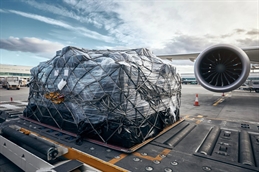
Global air cargo tonnages continued to build in the final full week of January, ahead of the Lunar New Year (LNY) on February 10, taking volumes for the last two weeks and for January as a whole well above their levels this time last year.
The latest figures from WorldACD Market Data showed January data as a whole showing a 14% increase compared with January 2023.
WorldACD noted, however, that the figures are skewed by LNY falling on January 22 last year, with the week following LNY typically seeing a significant drop in tonnages ex-Asia Pacific.
"Nevertheless, there has been an underlying trend of higher year-on-year tonnages for several months, boosted by strong e-commerce traffic demand ex-Asia Pacific since the final quarter (Q4) of last year and with some limited conversion of sea freight to air and sea-air cargo in recent weeks due to the disruptions to container shipping in the Red Sea," the air cargo market data provider, said.
Meanwhile, initial figures for week 4 (January 22 to 28) indicate that global air cargo tonnages rose by a further 5% compared with the previous week, following a 25% week-on-week (WoW) rise in week 2 and a further 4% increase in week 3, taking tonnages back up close to their levels in the final weeks of Q4.
WorldACD said average global prices have remained relatively stable throughout January, at an average of US$2.33 a kilo, compared with around US$2.60 in early to mid-December.
"Expanding the comparison period to two weeks, total combined tonnages for weeks 3 and 4 this year were up by 18%, globally, compared with the preceding two weeks (2Wo2W), with average rates stable and capacity up 3%," the report added.
Week-on-week, outbound tonnages were up significantly from most of the main global regions, on a 2Wo2W basis, including double-digit percentage increases from Central & South America (40%), Europe (28%), Asia Pacific (16%), North America (13%), and ex-Africa (10%).
Only ex-Middle East & South Asia (2%) traffic failed to record a significant increase, with the growth of 8% ex-Middle East & South Asia to Europe partially cancelled out by a decline (8%) to Asia Pacific.
WorldACD said this surge reflects a spike in demand for flowers in North America for Valentine's Day on February 14.
"South America to North America is the world's largest flower market and one that generates some big peaks in air cargo traffic, especially in late January for Valentine's Day and in April for Mother's Day. In contrast, the flower market to Europe is more stable, peaking usually in early February ahead of Valentine's Day," the report added.
Year-on-year (YoY) comparisons also reveal some big changes.
WorldACD noted that overall global demand in weeks 3 and 4, combined, is up 19%, compared with the equivalent period last year, with tonnages ex-Asia Pacific up by 42% and tonnages ex-Middle East & South Asia by 23%, followed by more-modest increases ex-Central & South America (12%), Africa (10%), and Europe (7%), while ex-North America demand is still in negative territory, YoY.
"That huge YoY difference ex-Asia Pacific underlines that this is primarily a LNY effect, although there is likely some contribution from sea freight converted to air and sea-air cargo due to the Red Sea disruptions," the report added.
Overall worldwide air cargo capacity remains significantly up on last year's levels (16%), including a 41% rise in ex-Asia Pacific that closely matches the demand situation from that market.
On the pricing side, average worldwide rates of US$2.33 per kilo in week 4 are 20% below their elevated levels this time last year, although they remain significantly above pre-Covid levels (+31% compared to January 2019).
Uncertain outlook noted
"Looking ahead, various freight and logistics commentators believe the boost to air cargo in recent weeks from sea freight conversions due to the Red Sea disruptions will drop away after the Lunar New Year," WorldACD said.
"However, one major forwarder notes that the knock-on effects and momentum in air cargo will continue even after LNY, with one of the main drivers being ocean container equipment shortages at origin ports due to the longer ocean shipping rotations around the Cape of Good Hope.
"With an increase in pressure on air cargo capacity, it expects a corresponding increase in air cargo rates in the coming weeks on some specific trade lanes, as it has already experienced in recent weeks," WorldACD added.



